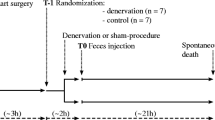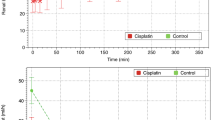Abstract
Background
Laparoscopic donor nephrectomy has become the first choice for living donor kidney transplantation, offering advantages over open donor nephrectomy. This study aimed to evaluate kidney tissue metabolism during and after pneumoperitoneum using a microdialysis technique.
Methods
Eight pigs underwent laparotomy and implantation of two microdialysis catheters: one in the cortex and one in the medulla of the left kidney. After laparotomy, the abdominal wall was closed, and pneumoperitoneum was induced with a constant standard pressure of 16 to 18 mmHg for 4 h, followed by rapid desufflation. In microdialysis samples collected from intrarenal catheters, markers of ischemia (glucose, lactate, pyruvate, and lactate–pyruvate ratio) and the marker of cell membrane injury (glycerol) were monitored.
Results
There were no changes in glucose, lactate, or pyruvate level before, during, or after pneumoperitoneum, either in the cortex or in the medulla. Additionally, the calculated lactate–pyruvate ratio did not show signs of ischemia during or after pneumoperitoneum. However, with regard to the marker of cell injury, glycerol increased in the medulla after decompression from 22.57 ± 3.76 to 35.67 ± 5.43 mmol/l (p < 0.01). This release of glycerol in the medulla was significantly higher than in the cortex (area under the curve [AUC], 22.18 ± 4.87 vs 34.79 ± 7.88 mmol/l; p < 0.01).
Conclusions
The pattern of metabolic changes monitored in the kidney during and after pneumoperitoneum indicates some kind of cell injury predominant in the medulla without any signs of kidney ischemia. This nonischemic injury could be related to hyperperfusion of the kidney after decompression or injury to cells attributable to mechanical cell expansion at the point of rapid decompression.





Similar content being viewed by others
References
Ratner LE, Ciseck LJ, Moore RG, Cigarroa FG, Kaufman HS, Kavoussi LR (1995) Laparoscopic live donor nephrectomy. Transplantation 60:1047–1049
Ratner LE, Hiller J, Sroka M (1997) Laparoscopic live donor nephrectomy removes disincentives to live donation. Transplant Proc 29:3402–3403
Tanabe K, Miyamoto N, Ishida H, Shirakawa H, Yamamoto H, Kondo T, Okuda H, Shimmura H, Ishikawa N, Nozaki T, Toma H (2005) Retroperitoneoscopic live donor nephrectomy (RPLDN): establishment and experience of RPLDN at a single center. Am J Transplant 5:739–745
Regan JP, Cho ES, Flowers JL (2003) Small bowel obstruction after laparoscopic donor nephrectomy. Surg Endosc 17:108–110
Ratner LE, Motgomery RA, Maley WR (2000) Laparoscopic live donor nephrectomy: the recipient. Transplantation 69:2319–2323
Flowers JL, Jacobs S, Cho ES (1997) Comparison of open and laparoscopic live donor nephrectomy. Ann Surg 226:483–489
Nogueira JM, Cangro CB, Fink JC (1999) A comparison of recipient renal outcomes with laparoscopic versus open live donor nephrectomy. Transplantation 67:722–728
Bito L, Davson H, Levin E, Murray M, Snider N (1966) The concentration of free amino acids and other electrolytes in cerebrospinal fluid, in vivo dialysis of brain, and blood plasma of the dog. J Neurochem 13:1057–1067
Gutierrez A, Anderstam B, Alvestrand A (1999) Amino acid concentration in interstitium of human skeletal muscle: a microdialysis study. Eur J Clin Invest 29:947–952
Amer P, Bolinder J (1991) Microdialysis of adipose tissue. J Intern Med 230:381–386
Bolinder J, Ungerstedt U, Arner P (1992) Microdialysis measurement of the absolute glucose concentration in subcutaneous adipose tissue allowing glucose monitoring in diabetic patients. Diabetologia 35:1177–1180
Tian YH, Schafer T, Sckell A, Schilling MK (2000) Adenosine deaminase inhibition attenuates reperfusion low flow and improves graft survival after rat liver transplantation. Transplantation 69:2277–2281
Hickman R, Rose-Innes C, Tyler M, Bracher M, Lotz Z, Fourie J (1992) Energy charge as an indication of liver viability: a comparison of changes in livers that remained intact with those subjected to autografting. Transplantation 53:540–545
Harken AH (1976) Lactoacidosis. Surg Gynecol Obstet 142:593–606
Hillered L, Valtysson J, Enblad P, Persson L (1998) Interstitial glycerol as a marker for membrane phospholipid degradation in the acutely injured human brain. J Neurol Neurosurg Psychiatry 64:486–491
Suzuki M, Yamaki T, Takeuchi H, Unno M, Katayose Y, Kakita Y, Rahman MM, Matsuno S (2001) Hemodynamic patterns of phosphatidylcholine hydroperoxide and hyaluronic acid during hepatic ischemia-reperfusion. J Hepatobiliary Pancreat Surg 8:161–168
Jakimowicz J, Stultiens G, Smulders F (1998) Laparoscopic insufflation of the abdomenreduces portal venous flow. Surg Endosc 12:129
Nowak G, Ungerstedt J, Wernerman J, Ungerstedt U, Ericzon BG (2002) Metabolic changes in the liver graft monitored continuously with microdialysis during liver transplantation in a pig model. Liver Transplant 5:424–432
Cay A, Imamoglu M, Unsal MA, Aydin S, Alver A, Akyol A, Sarihan H (2006) Does antioxidant prophylaxis with melatonin prevent adverse outcomes related to increased oxidative stress caused by laparoscopy in experimental rat model? J Surg Res Sep 135:2–8
Author information
Authors and Affiliations
Corresponding author
Rights and permissions
About this article
Cite this article
Iwata, T., Gilispie, A., Jorns, C. et al. Microdialysis monitoring for evaluation of the influence exerted by pneumoperitoneum on the kidney: an experimental study. Surg Endosc 22, 938–942 (2008). https://doi.org/10.1007/s00464-007-9525-0
Received:
Revised:
Accepted:
Published:
Issue Date:
DOI: https://doi.org/10.1007/s00464-007-9525-0




